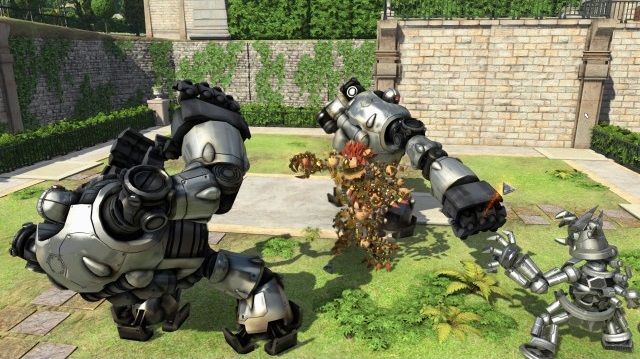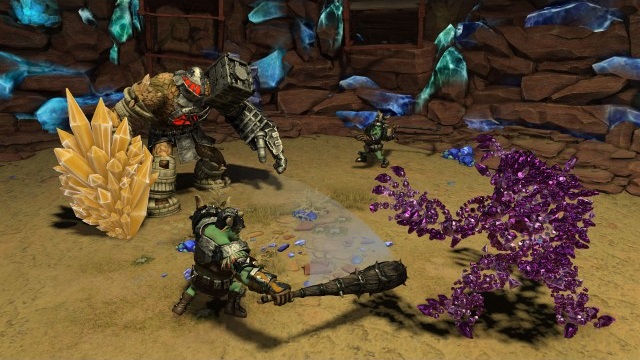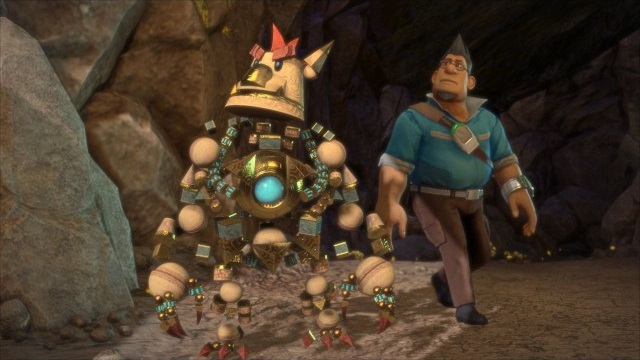Knick-knack paddy whack.
Knack signifies two experiments in one: Knack himself as a technological marvel and construct comprised of ancient relics held together by an energy core, and Knack the game as an attempt to combine old-school difficulty and linear game design with new-school graphics and a checkpoint system. Unfortunately, neither the character nor the hybrid design results in a venture worthy of the next-generation of consoles. Somewhere in its desire to be a cutthroat third-person action adventure like Dark Souls and its other desire to be a kid-friendly, pleasant romp through what by all appearances looks like a Pixar film, Knack becomes a befuddled, repetitive mess.
There's no doubt that Knack is reminiscent of retro games in its inherent difficulty, where our titular character can be taken out in two hits—three, if you're lucky—on the normal setting. Due to the number of hard-hitting enemies on the field and not knowing how to approach them at first, expect Knack to be knocked out hard and fast a countless number of times. I agree with old-school gamers that games should be more challenging than they are today, but difficulty is an artificial construct, a knob that in this case merely controls how much damage enemies inflict and how much life Knack has.
Moreover, at the same time, Knack wants to be lenient by imposing a checkpoint system where Knack can respawn infinitely. This allows you to finish all thirteen levels right up to the final guardian battle, but not without a heavy dose of frustration along the way. Since enemies hit ridiculously hard, your best bet is usually to get Knack inside quickly and use the fast priority of his punch to knock out enemies before they can strike. This is because Knack's dodge is practically useless since it makes him vulnerable in its recovery state and his aerial attack has a chance of not homing properly, leaving him vulnerable yet again.
As a result, combat becomes a trial-and-error affair where you ride on the coattails of temporary learning, aggressiveness, and dumb luck. Getting killed is obscenely punitive, forcing you to defeat the same enemies ad nauseum until you reach the next checkpoint, just so you can start the process over again. Collecting health pickups is a joke as well, returning barely a smidgeon of life. The same goes for sunstones, whose power can be used to create a storm of relics, an area-of-effect ground burst, or a trio of projectiles that are essentially a "get out of jail free" card. But dying and restarting at a checkpoint doesn't return sunstone power, so you'll save sunstone power only for the most dire situations.
The core problem with Knack, though, is not its difficulty insomuch as its repetition and predictability. Every level comes in five sections, with Knack starting in his smallest form in the first section and gradually gathering enough relics to become a giant by the final section. By the end of the level, something inevitably happens to Knack that forces him to return to his initial diminutive size. Repeat this twelve times and you have Knack's overaching design.

But that's not the only cyclical pattern. Within each extremely linear level, expect Knack to face a group of two to four enemies, then move through a platforming section by double-jumping or climbing, then face another group of two to four enemies, then move through a platforming section, and so on and so forth. Enemies will come in five sizes to reflect the sizes of Knack, and some will fire projectiles while others will swing a melee weapon. Sometimes he will need to dodge obvious traps, or he'll find a treasure chest or sunstones behind an equally obvious breakable wall. There is very little platforming during battle sections and very little battling during platforming sections. Repeat this about fifty times and you have Knack's basic design for a single level.
Worsening the redundancy is a lack of character progression. Knack learns not a single, permanent, new attack after the tutorial. While he becomes more powerful as he gets larger, and the game finally becomes enjoyable during sections where he smashes enemies to smithereens, he frequently sacrifices relics to open a door and he always loses all his power by the end of the level. Even Samus would say that's excessive. Sometimes Knack collects metal, wood, or clear crystals to transform himself with extra power, but these enhancements are temporary. He can also obtain upgrades by opening treasure chests found behind breakable walls, but every upgrade comes in pieces and it's not until the last few stages that you'll find those last required parts to form a single upgrade. However, if you missed but one part throughout the entire game, you're out of luck.
The only relief is the local co-op, where the second player acts as a smaller robot that operates like Tails from Sonic the Hedgehog 2 in that he has infinite lives and teleports to Knack if he's off-camera for too long. Better yet, the robot also distracts enemies, earns health by hitting enemies, and can give a portion of its health to Knack. In fact, this robot should have been Knack all along. However, the camera doesn't center on both characters (the Lego games do this much better) and the second player is encouraged to do all the work since it's safer than having the first player get killed and have both players be forced to restart at the last checkpoint.

The story doesn't fare much better, chock-full of cliché plotlines and characters, particularly the women who either play the damsel in distress or the cold-hearted bitch. This may be a kids game, but that doesn't mean its characters need to be one-dimensional and far too easily convinced to change their minds. Knack's creator, the doctor, continually praises how much effort everyone does, despite Knack doing all of the work. Knack himself, though sentient, lacks self-reflection and doesn't question his identity, merely following the doctor's orders and saving humanity even if the violent goblin tribes are merely reacting to what the humans have done to them.
Knack's presentation is one of its only saving graces, with vibrant environments, rounded and gorgeous modeling, smooth animations, and solid voice-acting. The soundtrack is passable, albeit monotonous and forgettable. On the surface at least, Knack is fairly innocuous and, provided you're a player with a lot of patience or are playing co-op, there's a chance you'll tolerate the difficulty long enough to reach the end.
That said, although Knack is an exclusive title for the PlayStation 4, it's last-gen at best and last-last-gen at worst. It's an average effort with an interesting concept for a protagonist and a game that lasts for several days only because it's unnecessarily padded and punitive to a fault. Knack may be built on the blocks of charm and difficulty, but by the fourth level, those blocks topple over into a pile of excess tedium.
-
Strong concept for protagonist
-
...that doesn't go anywhere in the story
-
Boilerplate characters
-
Beautiful environments and cel-shaded graphics
-
Old-school difficulty
-
...but punitive checkpoint system
-
Repetitive level design
-
Extremely padded
-
Poor character progression











